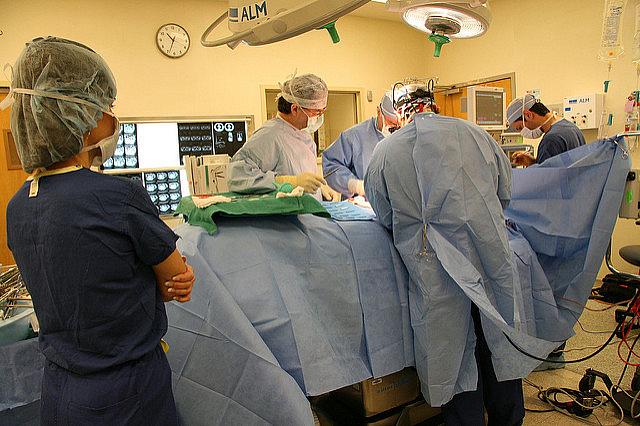Superficial coverage of medical errors could leave erroneous impression with readers

The health news media were hopping recently with a big story about medical errors.
Seemingly all the major outlets carried the story, with headlines so alarming that they’d have any conscious hospital patient demanding an immediate discharge.
- CBS: Medical errors now 3rd leading cause of death in U.S., study suggests
- Washington Post: Researchers: Medical errors now third leading cause of death in United States
- Nature World News: Medical Errors Now the Third Leading Cause of Mortality in U.S.
These headlines all bore a striking resemblance to that of a Johns Hopkins news release about the study: Study Suggests Medical Errors Now Third Leading Cause of Death in the U.S.
I call attention to the word “now” used in all of these headlines — which suggests to the casual reader that the rate of medical errors is the United States is on the rise.
But that’s not what the BMJ paper found. And it’s not how the paper described its conclusion in its own title: Medical error—the third leading cause of death in the US.
Using data from several older studies, the BMJ paper used a mathematical model to extrapolate a new and different total for medical error related deaths. And that total — more than 250,000 — is higher than estimates from previous research.
But the paper did not attempt to assess trends in the rate of medical error-related deaths, nor did it collect any new data. So it’s dubious to suggest — without explanation — that errors are “now” coming into 3rd place.
Out of the many stories I read on this topic, only Bloomberg’s coverage explicitly addressed whether medical errors are actually increasing as implied in these headlines. Their story noted:
That doesn’t mean deaths from medical errors have increased since the 1990s. Because different methodologies were used to come up with the numbers, it’s hard to say what the trend looks like.
I’ll grant that this is a fine point and maybe even a little nitpicky. And if that were the only problem with the coverage, then I wouldn’t be writing this post.
But the problems run deeper than ambiguous headlines. As the blogger known as Skeptical Scalpel (a self-described former chairman of surgery) points out, the BMJ paper takes some pretty big leaps to come up with its new national total for error-related deaths. And the idea that all of these deaths are entirely preventable is also open to debate, he observes.
Makary’s review extrapolated that figure [~250,000 deaths] from three papers published before 2009 which had a combined 35 supposedly preventable deaths. That’s not a typo—35 deaths in all. One of the papers stated that all 9 deaths in three tertiary care hospitals were preventable. In his BMJ paper, Makary says, “some argue that all iatrogenic deaths are preventable.”
I disagree. I have analyzed other papers on this subject and pointed out that certain complications and deaths are not 100% preventable. For example, no study of deep venous thrombosis and pulmonary embolism shows total efficacy of any prevention strategy. And some patients will suffer myocardial infarctions and die even when they are properly treated.
Thirty five deaths extrapolated to 250,000?
I’d like to have seen more reporters taking a closer look at those calculations.
Vinay Prasad, MD, MPH, an Assistant Professor of Medicine at the Oregon Health and Sciences University, told me in a telephone interview that he was also underwhelmed by the news media coverage of the study. He said it’s “a very uncertain science” bordering on “rampant speculation” to ascertain whether a particular medical intervention or error would or would not have resulted in the death of a patient.
This is not like the Vietnam War where you know exactly who was a victim of the conflict. When the public hears a statistic like ‘251,454 deaths,’ they get the impression that these are people whose names you could put on a wall — but that’s not the case at all.
And he said that the framing of medical errors as the “third leading cause of death” is also likely to leave a misleading impression. Whereas any error is regrettable, he said, his suspicion is that some of these deaths are happening in very sick, elderly patients whose death was imminent regardless of what care they received.
When someone is 19 and they’re missing out on 70 years of lost life because of a medical error, that’s much different than when someone is 85 years old, already on a ventilator, and is likely to die any day now.
None of this is meant to excuse or diminish the problem of medical errors. Whether the total is 50,000 or 250,000, the number is too high and arguably under-appreciated.
But when news outlets join in lockstep to promote a sensational and possibly inflated figure without carefully vetting the underlying evidence or providing context, that’s also a significant problem whose ultimate consequences are unknown.
Prasad said that it’s possible that any attention to medical errors — even if the problem is overstated — would ultimately promote useful change in practices that would lead to better care for patients.
But he said it’s also possible that such attention could lead people to avoid the medical system entirely or seek out alternative forms of care that are not effective. And that would be a net loss. He added that he could also envision scenarios where, in reaction to the perceived massive problem of medical errors, hospitals “create some nightmarish bureaucratic solution” that ends up harming patients in unintended ways.
Prasad said it’s impossible to predict these eventual long-term repercussions, which is why journalists have to focus on more immediate objectives: accuracy and context.
“Communicating accurately is a virtue no matter what the downstream consequences are,” he said.
This article was originally posted on HealthNewsReview.org and is republished here with permission. Kevin Lomangino is HealthNewsReview.org's managing editor.
[Photo by Artur Bergman via Flickr.]


